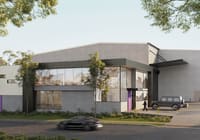
This $85b property veteran has three ‘high conviction’ bets this year
David Harrison, chief executive of the $85 billion property giant Charter Hall, can feel the FOMO building among his investor base.
Lower interest rates, stabilising vacancies and valuations, supply shortages across all property asset classes, and solid population growth through immigration all create a recipe for an improving environment. And Harrison, one of the many heavy hitters to front the Financial Review Property Summit in Sydney says investors of all shapes and sizes can see what’s coming.

“They want to get in in the early part of the cycle, which is why FOMO emerges, and people want to get in and get invested. Because, you know, in any cycle, whether it’s property or listed equities, you make most of your money in the early part of the cycle, rather than investing at the later part of the cycle.”
But as several speakers at the summit said, including Dexus chief executive Ross Du Vernet, the easy days of low interest rates pumping up asset values across the property sector are gone. An active approach – the property version of stock picking – will be crucial in the next few years.
So where’s Harrison looking?
Three big bets on the future of property
The first is convenience retail, which includes neighbourhood shopping centres and petrol stations. Harrison says there’s been a 70 per cent reduction in supply of retail space, and majors such as Coles, Woolworths and Aldi are “not rolling out new stores anything like they used to because the development equation doesn’t stack up versus just refurbishing stores.”
But where they do redevelop existing stores, sales go up, and because most leases are linked to sales, so do rents – perfect conditions for landlords.
“I’m happy as Larry there’s a supply crisis there because our existing assets will do very well,” he says.
Harrison’s second target is industrial property. This was an area of some debate on Monday. While Damian Graham, chief investment officer at Aware Super, says his fund has focused heavily on industrial property in recent years, Mirvac boss Campbell Hanan said there were signs the boom period in logistics property is starting to come off.
But that doesn’t worry Harrison. “We’ve steered clear of the reversion romance, where everyone thought trees grow the sky and that you’ll keep getting double-digit rental growth in perpetuity – there’s no sector in the world that does that,” he says. “We’ve stuck with our thesis of modern assets with long leases, and that’ll play out well.”
Harrison’s third bet is perhaps the most surprising: office property. The bifurcation of CBDs is a well-told story – Du Vernet says that even within Sydney, vacancy rates can vary from 2 per cent in the most premium buildings to 30 per cent on the western side of the city – but Harrison says the story being told by capital flows is very real.
“I wouldn’t say it’s going to be a boom, but there’ll be very strong tailwind pressures on modern office because capital follows tenants. So if all the tenants want to be there and there’s no vacancy, well, guess what? That’s where the capital wants to be.”
In most parts of the commercial property sector, capitalisation rates – the property sector’s version of yield – have been on a bit of a rollercoaster in recent years, falling dramatically in 2020 with lower rates and surging asset values, rising again as rates went up and then coming back down more recently. But Harrison says capitalisation rates in office property are still 100 basis points above June 2020 levels, which reflects depressed valuations.
“It’ll take a little longer to start seeing cap rates compress than say, convenience retail and industrial, but I think it’ll be more pronounced than people think over the next 24 months,” he says.











